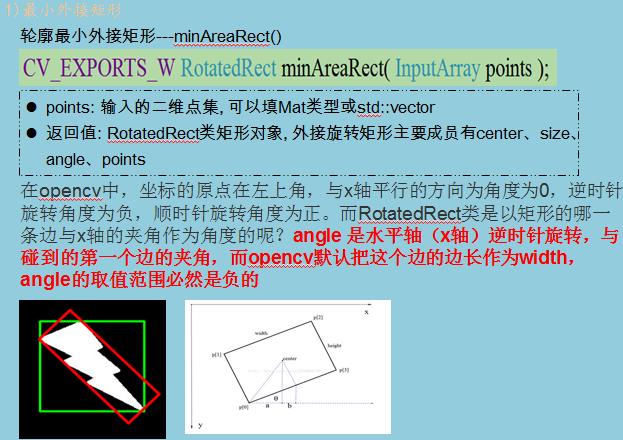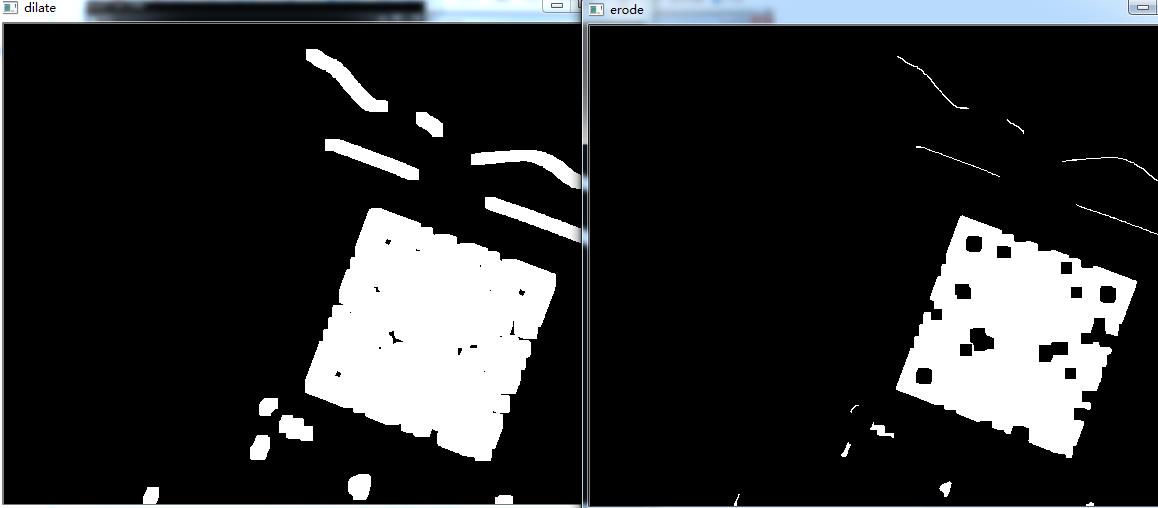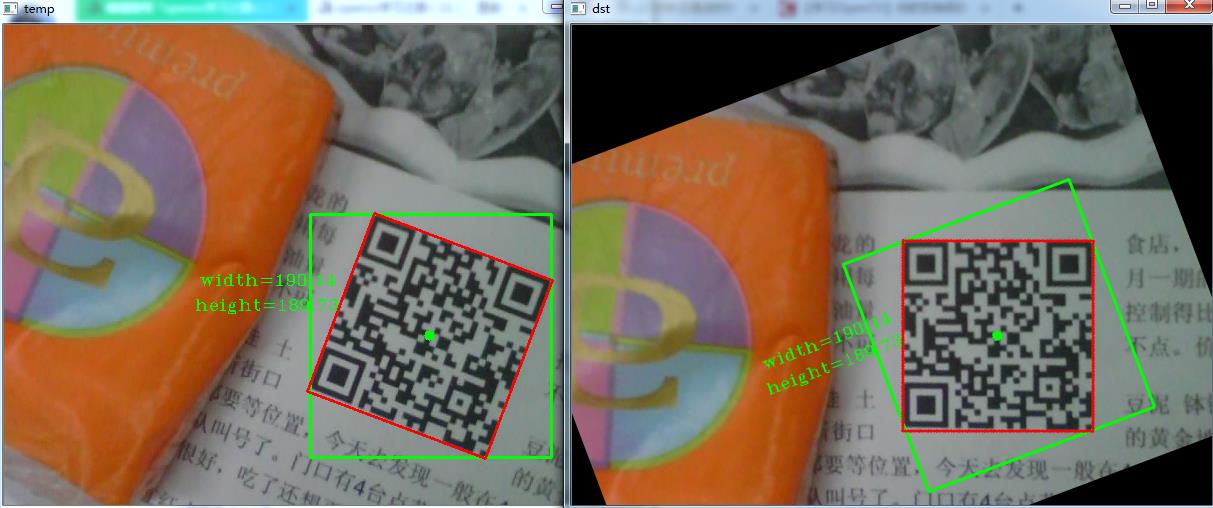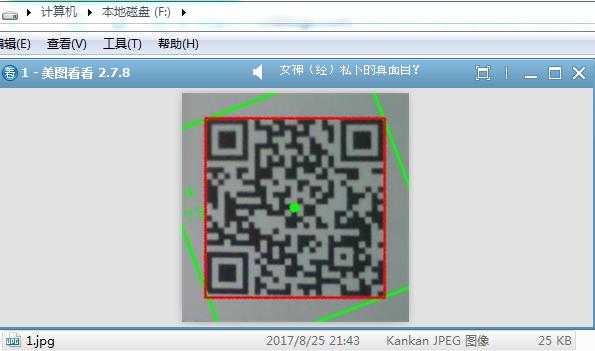opencv学习之路(26)轮廓查找与绘制——最小外接矩形
Posted 进击的小猴子
tags:
篇首语:本文由小常识网(cha138.com)小编为大家整理,主要介绍了opencv学习之路(26)轮廓查找与绘制——最小外接矩形相关的知识,希望对你有一定的参考价值。
一、简介

二、轮廓最小外接矩形的绘制
1 #include "opencv2/opencv.hpp" 2 using namespace cv; 3 4 void main() 5 { 6 //轮廓最小外接矩形的绘制 7 Mat srcImg = imread("E://00.png"); 8 Mat dstImg = srcImg.clone(); 9 cvtColor(srcImg, srcImg, CV_BGR2GRAY); 10 threshold(srcImg, srcImg, 100, 255, CV_THRESH_BINARY); //二值化 11 imshow("threshold", srcImg); 12 13 vector<vector<Point>> contours; 14 vector<Vec4i> hierarcy; 15 findContours(srcImg, contours, hierarcy, CV_RETR_EXTERNAL, CV_CHAIN_APPROX_NONE); 16 vector<Rect> boundRect(contours.size()); //定义外接矩形集合 17 vector<RotatedRect> box(contours.size()); //定义最小外接矩形集合 18 Point2f rect[4]; 19 for(int i=0; i<contours.size(); i++) 20 { 21 box[i] = minAreaRect(Mat(contours[i])); //计算每个轮廓最小外接矩形 22 boundRect[i] = boundingRect(Mat(contours[i])); 23 circle(dstImg, Point(box[i].center.x, box[i].center.y), 5, Scalar(0, 255, 0), -1, 8); //绘制最小外接矩形的中心点 24 box[i].points(rect); //把最小外接矩形四个端点复制给rect数组 25 rectangle(dstImg, Point(boundRect[i].x, boundRect[i].y), Point(boundRect[i].x + boundRect[i].width, boundRect[i].y + boundRect[i].height), Scalar(0, 255, 0), 2, 8); 26 for(int j=0; j<4; j++) 27 { 28 line(dstImg, rect[j], rect[(j+1)%4], Scalar(0, 0, 255), 2, 8); //绘制最小外接矩形每条边 29 } 30 } 31 imshow("dst", dstImg); 32 waitKey(0); 33 }

三、粗略计算物体像素长宽
1 #include "opencv2/opencv.hpp" 2 #include<iostream> 3 using namespace std; 4 using namespace cv; 5 6 void main() 7 { 8 Mat srcImg = imread("E://cup.jpg"); 9 imshow("src", srcImg); 10 Mat dstImg = srcImg.clone(); 11 medianBlur(srcImg, srcImg, 5); 12 GaussianBlur(srcImg, srcImg, Size(3, 3), 0, 0); 13 cvtColor(srcImg, srcImg, CV_BGR2GRAY); 14 threshold(srcImg, srcImg, 100, 255, CV_THRESH_BINARY_INV); //INV是因为背景白色,物体黑色,需要反转一下 15 imshow("threshold", srcImg); 16 17 vector<vector<Point>> contours; 18 vector<Vec4i> hierarcy; 19 20 findContours(srcImg, contours, hierarcy, CV_RETR_EXTERNAL, CV_CHAIN_APPROX_NONE); 21 cout<<"num="<<contours.size()<<endl; 22 vector<Rect> boundRect(contours.size()); 23 vector<RotatedRect> box(contours.size()); 24 Point2f rect[4]; 25 for(int i=0; i<contours.size(); i++) 26 { 27 box[i] = minAreaRect(Mat(contours[i])); 28 boundRect[i] = boundingRect(Mat(contours[i])); 29 cout<<box[i].angle<<endl; 30 cout<<box[i].center<<endl; 31 cout<<box[i].size.width<<endl; 32 cout<<box[i].size.height<<endl; 33 circle(dstImg, Point(box[i].center.x, box[i].center.y), 5, Scalar(0, 255, 0), -1, 8); 34 35 //绘制外接矩形和 最小外接矩形(for循环) 36 rectangle(dstImg, Point(boundRect[i].x, boundRect[i].y), Point(boundRect[i].x + boundRect[i].width, boundRect[i].y + boundRect[i].height), Scalar(0, 255, 0), 2, 8); 37 box[i].points(rect);//把最小外接矩形四个端点复制给rect数组 38 for(int j=0; j<4; j++) 39 { 40 line(dstImg, rect[j], rect[(j+1)%4], Scalar(0, 0, 255), 2, 8); 41 } 42 43 char width[20], height[20]; 44 sprintf(width, "width=%0.2f", box[i].size.width); 45 sprintf(height, "height=%0.2f", box[i].size.height); 46 putText(dstImg, width, Point(235, 260), CV_FONT_HERSHEY_COMPLEX_SMALL, 0.85, Scalar(0, 255, 0)); 47 putText(dstImg, height, Point(235, 285), CV_FONT_HERSHEY_COMPLEX_SMALL, 0.85, Scalar(0, 255, 0)); 48 49 } 50 imshow("dst", dstImg); 51 waitKey(0); 52 }

四、倾斜物体矫正提取
1 #include "opencv2/opencv.hpp" 2 #include<iostream> 3 using namespace std; 4 using namespace cv; 5 6 void main() 7 { 8 Mat srcImg = imread("E://qrcode.jpg"); 9 imshow("src", srcImg); 10 Mat dstImg = srcImg.clone(); 11 GaussianBlur(srcImg, srcImg, Size(3, 3), 0, 0); 12 cvtColor(srcImg, srcImg, CV_BGR2GRAY); 13 Canny(srcImg, srcImg, 100, 200);//因为原图比较复杂,所以需要将canny的值调大,去除不想要的成分 14 //threshold(srcImg, srcImg, 100, 255, CV_THRESH_BINARY_INV); //二值化也可以实现canny效果,不过在本例中杂絮较多 15 imshow("canny", srcImg); 16 Mat element = getStructuringElement(MORPH_RECT, Size(11, 11), Point(-1, -1)); //定义结构元素 17 dilate(srcImg, srcImg, element); //膨胀 18 imshow("dilate", srcImg); 19 erode(srcImg, srcImg, element); 20 imshow("erode", srcImg); 21 22 vector<vector<Point>> contours; 23 vector<Vec4i> hierarcy; 24 findContours(srcImg, contours, hierarcy, CV_RETR_TREE, CV_CHAIN_APPROX_NONE); 25 vector<Rect> boundRect(contours.size()); 26 vector<RotatedRect> box(contours.size()); 27 Point2f rect[4]; 28 for(int i=0; i<contours.size(); i++) 29 { 30 box[i] = minAreaRect(Mat(contours[i])); 31 boundRect[i] = boundingRect(Mat(contours[i])); 32 33 if(box[i].size.width < 100 || box[i].size.height<100)//筛选 34 continue; 35 rectangle(dstImg, Point(boundRect[i].x, boundRect[i].y), Point(boundRect[i].x + boundRect[i].width, boundRect[i].y + boundRect[i].height), Scalar(0, 255, 0), 2, 8); 36 circle(dstImg, Point(box[i].center.x, box[i].center.y), 5, Scalar(0, 255, 0), -1, 8); 37 box[i].points(rect); 38 for(int j=0; j<4; j++) 39 { 40 line(dstImg, rect[j], rect[(j+1)%4], Scalar(0, 0, 255), 2, 8); 41 } 42 43 float angle; 44 cout<<"angle="<<box[i].angle<<endl; 45 angle = box[i].angle; 46 char width[20], height[20]; 47 sprintf(width, "width=%0.2f", box[i].size.width); 48 sprintf(height, "height=%0.2f", box[i].size.height); 49 putText(dstImg, width, Point(195, 260), CV_FONT_HERSHEY_COMPLEX_SMALL, 0.85, Scalar(0, 255, 0)); 50 putText(dstImg, height, Point(190, 285), CV_FONT_HERSHEY_COMPLEX_SMALL, 0.85, Scalar(0, 255, 0)); 51 imshow("temp", dstImg); 52 53 //利用仿射变换进行旋转 另一种方法,透视变换 54 if (0< abs(angle) && abs(angle)<=45) 55 angle = angle;//负数,顺时针旋转 56 else if (45< abs(angle) && abs(angle)<90) 57 angle = 90 - abs(angle);//正数,逆时针旋转 58 Point2f center = box[i].center; //定义旋转中心坐标 59 double angle0 = angle; 60 double scale = 1; 61 Mat roateM = getRotationMatrix2D(center, angle0, scale); //获得旋转矩阵,顺时针为负,逆时针为正 62 warpAffine(dstImg, dstImg, roateM, dstImg.size()); //仿射变换 63 64 //保存二维码 65 int x0=0, y0=0, w0=0, h0=0; 66 x0 = boundRect[i].x; 67 y0 = boundRect[i].y; 68 w0 = boundRect[i].width; 69 h0 = boundRect[i].height; 70 Mat ROI = dstImg(Rect(x0, y0, w0, h0)); 71 imwrite("F://1.jpg", ROI); 72 } 73 imshow("dst", dstImg); 74 waitKey(0); 75 }




以上是关于opencv学习之路(26)轮廓查找与绘制——最小外接矩形的主要内容,如果未能解决你的问题,请参考以下文章